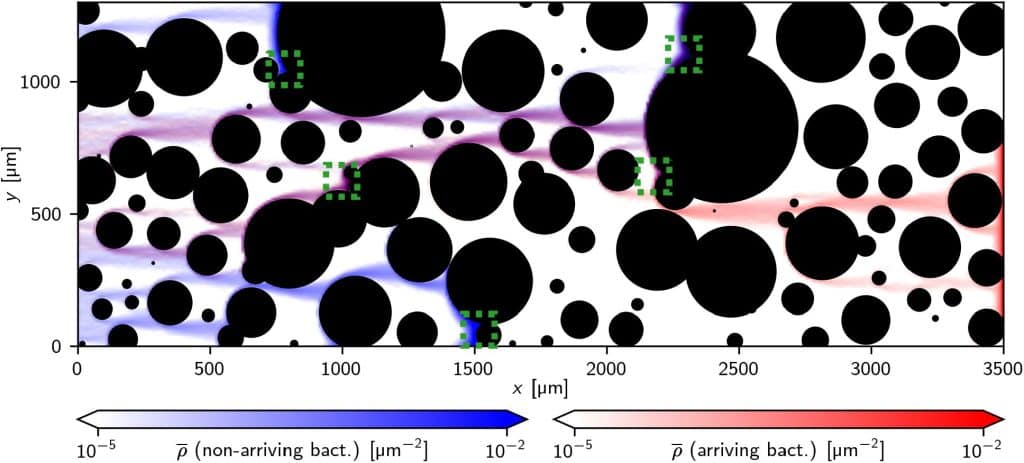Researchers have shed light on the fascinating behavior of magnetotactic bacteria, which use the Earth’s magnetic field to navigate in complex environments. These microorganisms, which live within sediments, have demonstrated a unique ability to adapt their movement to avoid obstacles. A discovery that opens up new avenues on the understanding of microbial motility and the evolution of bacteria, en route towards applications in bioremediation or medicine.
The role of the Earth's magnetic field in bacterial navigation
Magnetotactic bacteria are microorganisms inhabiting sediments where they swim and orient using chains of magnetic nanoparticles. These nanomagnets allow the bacteria to align with the Earth’s magnetic field, helping in their search for optimal living conditions. Motility studies of these bacteria had been conducted so far in simple aqueous solutions such as water, far from the complexity of their natural environment, the sediment, composed of grains of sand of various shapes and sizes.
Thus, navigating in such an environment presents an additional challenge. The BIAM researchers and their collaborators aimed to understand how these bacteria react when they encounter obstacles simulating those of their natural habitat. They also looked at how the Earth’s magnetic field and in particular its intensity, influenced the bacteria’s ability to reach their destination by bypassing obstacles.
Map of microfluidic channels for observing the movement of bacteria
This diagram shows the movements of 2000 bacteria simulated for 30 minutes in an environment with a weak magnetic field (50 µT similar to that of the Earth) oriented from left to right. The blue areas indicate the bacteria that did not reach the right end of the channel, while the red areas show those that did. The green boxes highlight natural “traps” formed by obstacles in the channel, blocking or slowing down certain bacteria. This phenomenon is due to the interaction between the magnetic field and the shape of the channel, which creates specific paths that the bacteria take.

A major discovery: the optimal intensity of the magnetic field
The research group demonstrated that the intensity of the Earth’s magnetic field plays a crucial role in guiding bacteria. They showed that a certain flexibility was required to avoid trapping the bacteria in areas that are difficult to circumvent. Experiments carried out in microfluidic channels, reproducing the characteristics of sediments, showed that bacteria swim more efficiently when the intensity of the magnetic field is close to that of the Earth’s field. A field that is too strong will lead the bacteria to be blocked in “corners” formed by obstacles, while a field that is too weak leads to a random orientation, making their movement inefficient.
A multidisciplinary approach to characterize bacterial movement
“To obtain these results, we combined several techniques, including optical microscopy under a magnetic field and sophisticated computer simulations,” reveals Damien Faivre, a researcher at the institute. “The simulations, based on a model of active Brownian particles (see box), made it possible to reproduce the trajectories observed experimentally and to precisely quantify the swimming of bacteria according to different obstacle geometries.” The experiments confirmed the trapping effect at high magnetic field intensity, and thus showed that reducing the intensity allows bacteria to escape.
The results also suggest that magnetotactic bacteria have evolved to adapt to geomagnetic field conditions over time, optimizing their ability to orient themselves and move in complex environments such as sediments. This adaptation could give them an advantage in finding favorable living conditions while avoiding getting stuck.
Towards new research on bacterial motility
With these results in hand, the team plans to deepen to reproduce even more faithfully the natural conditions observed in sediments. “This approach could open new avenues of research on the motility of microorganisms in complex environments, and perhaps inspire applications in other fields, such as bioremediation or the development of autonomous microrobots for highly targeted medical interventions, for example”.
Active Brownian particle model
This model describes the behavior of particles that can move autonomously, using their own energy, such as bacteria. Unlike classical Brownian motion, which is entirely random, active particles can orient their trajectory according to external stimuli, such as magnetic fields or obstacles. This model can be used to analyze how particles navigate in complex media by combining directed movements and random interactions with their environment. It is particularly useful for studying the motility of microorganisms and other autonomous systems.
Autors : Agnese Codutti, Mohammad A Charsooghi, Konrad Marx, Elisa Cerdá-Doñate, Omar Munoz, Paul Zaslansky, Vitali Telezki, Tom Robinson, Damien Faivre, Stefan Klumpp